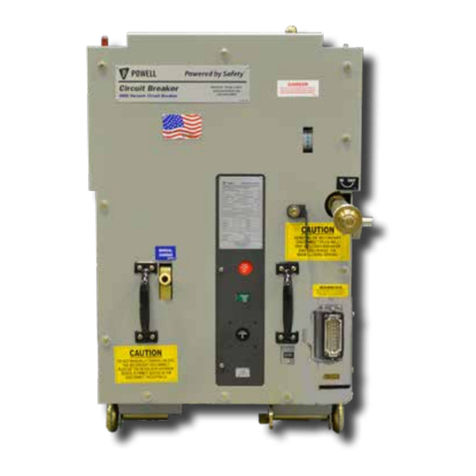
Powered by Safety®
ii
01.4IB.77000B
PowlVac-ND® Vacuum Circuit Breaker
Contents
e. InSertInG the cIrcuIt BreAker Into the cIrcuIt BreAker coMpArtMent ................................................................... 28
1) Prior to Inserting the Circuit Breaker into the Circuit Breaker Compartment .........................................................29
2) Inserting the Circuit Breaker to the Test/Disconnected Position ...............................................................................30
3) Inserting the Circuit Breaker to the Connected Position ..............................................................................................31
f. reMovInG the cIrcuIt BreAker froM the cIrcuIt BreAker coMpArtMent ................................................................ 32
1) Removing the Circuit Breaker from the Connected to the Test/Disconnected Position .......................................33
2) Removing the Circuit Breaker from the Test/Disconnected Position out of the
Circuit Breaker Compartment ............................................................................................................................................33
3) Remote Racking ....................................................................................................................................................................33
Ch 5 Maintenance ..........................................................................................................34
A. GenerAl DeScrIptIon ....................................................................................................................................... 34
1) Introduction ............................................................................................................................................................................34
2) Inspection and Cleaning ......................................................................................................................................................35
B. MechAnISM AreA ............................................................................................................................................. 36
1) Mechanical Operation .........................................................................................................................................................36
2) Lubrication ..............................................................................................................................................................................36
3) Closing Spring Removal .......................................................................................................................................................40
4) Slow Closing of Mechanism ................................................................................................................................................41
5) Mechanism Adjustments .....................................................................................................................................................41
6) Electrical Operation ..............................................................................................................................................................46
c. vAcuuM Interrupter AnD contAct AreA ............................................................................................................ 46
1) Vacuum Interrupter and Contact Erosion .......................................................................................................................46
2) Sliding Contact Finger Wear ...............................................................................................................................................47
3) Vacuum Integrity ...................................................................................................................................................................47
4) Mechanical Adjustment of Vacuum Interrupters ................................................................................................................47
D. optIonAl MAIntenAnce proceDureS .................................................................................................................. 47
1) High Potential Tests ..............................................................................................................................................................47
2) Timing .....................................................................................................................................................................................48
3) Primary Resistance Check ...................................................................................................................................................48
Ch 6 Recommended Renewal Parts and Replacement Procedures ..............................49
A. orDerInG InStructIonS ..................................................................................................................................... 49
B. recoMMenDeD reneWAl pArtS .......................................................................................................................... 49
c. replAceMent proceDureS ................................................................................................................................. 50
1) Vacuum Interrupter Assembly ............................................................................................................................................50
2) Closing Coil Assembly ...........................................................................................................................................................50
3) Primary Shunt Trip Coil Assembly ......................................................................................................................................50
4) Secondary Shunt Trip Coil Assembly .................................................................................................................................50
5) Undervoltage Device Assembly .........................................................................................................................................50
6) Charging Motor Assembly ..................................................................................................................................................50
7) Anti-Pump Relay Assembly .................................................................................................................................................50
8) Latch Check Switch ...............................................................................................................................................................50
9) Motor Cutoff Switch Assembly ...........................................................................................................................................50
10) Auxiliary Switch .....................................................................................................................................................................50




























